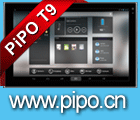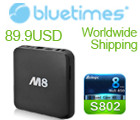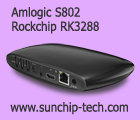At the IDTechEx show, Sharp demonstrates Memory LCD technology that delivers high-contrast, high-resolution displays for outdoor use. They are already being used in the quite popular Pebble watch. These LCD modules embed 1-bit memory in every pixel to enable each pixel to hold state while requiring low power. This delivers an “always on” display that uses little power (only a single supply voltage is required), even when updating images. This helps designers create products with long battery life. It also eliminates sweeping images or “ghosting”, because only the part of the image that requires updating needs to be changed. The response time of Sharp’s Memory LCDs makes it fast enough to display motion video. Right now Memory LCD is thus a quite good contender for the Smartwatch market, with Android Wear being a possibility also, perhaps Smartphones could use Memory LCD also to design a smartphone with potentially weeks of battery life instead of a day or two.
Maysun shows LTE phones on MT6732 with wireless charging and finger print
Maysun is an OEM/ODM manufacturer of smartphones now shipping models with LTE, finger printing, large battery capacities up to 5000mAh, wireless charging, their RMA rate is less than 4%. Founded in 2008, Maysun has its own R&D team and a big factory employing more than 300 workers at their assembly and SMT lines, Maysun outputs Smartphones with a production capacity of 8000 smartphones per day, 250 thousand smartphones per month. You can read more about Maysun at http://www.maysuncn.com/
Actions Bubblegum-96 Linaro 96Boards.org development board on quad-core ARM Cortex-A53
Actions Semiconductor launches their first 96boards development board running Android 5 Lollipop, Ubuntu based on Linaro codebase, based on Actions S900 Quad-core 64bit ARM Cortex-A53 with PowerVR G6230 GPU, Memory 1-8GB DDR3, Storage support 4-64GB eMMC. Rich interfaces including HDMI, USB2.0 host and Micro USB2.0, LAN, WIFI.
$180 E Ink and LCD dual-display 64bit MT6752 phone by Huateng
Huateng flag D1 is a Dual display smartphone with a 5″ FHD LCD and a 4.7″ E Ink display at 960×540, touch screen is on both sides, the phone is based on MT6752 Octa-core ARM Cortex-A53 64bit with Mali T760-MP2 GPU. 2G RAM and 16G Flash, Micro SD card support up to 64GB. Android5 is supported.
Bainisha Body Motion Capturing using Printed Electronics
Bainisha is a high-tech start-up dedicated to the development of a new paradigm in Body Motion Capturing. This interview, taken at the IDTechEx event on Wearable Technology, shows some of the product they are working on. Based on a thin hyper-stretchable film version of an Inverse Artificial Muscle, it delivers a set of new and hitherto unattained functionalities in terms of accuracy, speed & differentiation. The on-body concept guarantees an Absolute Body References Frame and hence sets a new standard for Medical Quality Data. Because the system has no “wake-up”-threshold and no filtering and/or damping combined with a +kHz capturing speed, it allows capturing such minute displacements as muscle tremor, pre-natal contractions, fatigue induced tremble etc… as well as explosive kinetics. Learn more about the technology and event at http://www.wearabletechnologyinsights.com
Microdul at IDTechEx Energy Harvesting & Storage event
Interview with Microdul at the IDTechEx Energy Harvesting & Storage event. Microdul AG is a specialist for high quality microelectronics with three business lines: Modules, Thick-film and Semiconductors. Microdul’s core competence is the production of cutting edge individual solutions in close cooperation with their customers. Their Semiconductors Group has experience in ultra-low power design of mixed-signal integrated circuits, which is particularly appropriate for energy harvesting and low-power sensor applications. To learn more about the event and energy harvesting see http://www.EnergyHarvestingJournal.com
Applied Graphene Materials interview at IDTechEx Graphene event
IDTechEx interview Applied Graphene Materials (AGM) at the IDTechEx Graphene & 2D Materials event in Berlin. AGM has developed and patented a proprietary “bottom up” process for the production of high-specification graphene. AGM claims that its process is continuous and scalable, produces high-quality graphene powders, does not require a substrate and uses sustainable and readily available raw materials (not from graphite), AGM’s production capacity has been expanded to support large volume graphene applications. AGM also has expertise to disperse graphene in a variety of solid matrices and solutions to deliver advanced materials optimised for many applications, including polymer composites, paints and coatings, thermal management, lubricants and functional fluids, barriers and films, supercapacitors and batteries. For more information about the event and graphene see http://www.IDTechEx.com
Andromium OS on MHL Lapdock, Productivity multi-window UI for Android
Gordon Zheng, Founder and Lead Developer, presents Andromium OS, described as a guest OS that run on top of Android, leveraging existing Android API’s as well as a new UI library to bring a productivity keyboard/mouse desktop style user experience similar to Windows and OSX. Currently Android does not support a true multi-window experience, however some manufactures like LG and Samsung have made some modification to android (ROM) to bring the side by side apps and windows app experience for their devices. Andromium takes a similar approach, while Samsung and LG’s approaches are exclusive to their devices, Andromium OS runs on any Android device as long as their device support Android version 4.4 and above. The next step for Andromium will be to release a Developer SDK and Andromium app store to the developer community, to grow the OS ecosystem.
The Andromium SDK, designed as an additional library that developers can import into their existing Android projects, allowing their android apps to inherit the Andromium OS multi-windows functionality, as well as have the correct UI elements for a keyboard and mouse interface. The Android developers can continue to use their favorite Developer environment: ADT or Eclipse, they just have to import Andromium’s library into their project.
Currently Andromium OS in on the Google playstore as a public beta, it is currently around 5mb download. Long term the OS/App will stay relatively small. Andromium can support most devices on Android 4.4 and above (including Lollipop). The Andromium OS/UI is hardware accelerated, so that users should experience 30fps or above according to the performance of the ARM Processor. For example on a Samsung Note 4, Andromium OS can play a 4k video, surf in the browser and still have close to 30fps ui rendering when moving or resizing the application windows.
For more information please see:
http://forum.andromiumos.com
http://www.andromiumos.com
E Ink Chief Strategy Officer Dr Paul Apen talks signage and architecture
At the IDTechEx show in Berlin, Sri Peruvemba, former CMO for E Ink, interviewed Dr Paul Apen, Chief Strategy Officer at E Ink. Paul had just completed a talk where he described E Ink’s work in signage and architectural applications.
Enfucell Printed Battery Powering Golf Sensor, Temperature Sensors and More
Enfucell is a customized battery supplier to the printed electronics industry. The company has developed SoftBattery®, a thin, flexible and eco-friendly printed power source and at the IDTechEx Printed Electronics Europe event in Berlin it showcased a range of products based on this battery. It includes a powered wireless golf sensor patch which was developed in a joint project with Qualcomm. The patch is attached to a golf club head for measuring acceleration and angular velocity. The acquired data is transferred via low energy Bluetooth (BLE) to an application on a mobile device. Enfucell battery powers the BLE data transmission without additional capacitor demonstrating the highest peak power capability in the industry. Battery is also fully integrated to the system.
The disposable patch is helping golf players to improve their swing. This is the first time that a player can actually get feedback from the club head. A fully integrated printed battery enables thin and light construction which does not interfere with the normal stroke. Thanks to the BLE communication, data can be analyzed on site on the driving range during a training session. The data is collected to and processed on an Android tablet.
A similar patch can be tailored for other racquet sports, shooting, bowling, etc. Enfucell is looking for partners for commercializing the product. The new product platform completes Enfucell application range with previously introduced temperature logger (collaboration with NXP) and iontophoresis patch (collaboration with The Ionto Team, Spain). Also these products have fully integrated Enfucell battery technology. All of these are shown in the video. To learn more see http://www.PrintedElectronicsWorld.com
ARM Instruction Set design history with Sophie Wilson (Part 3)
The first ARM processor was designed in 1983-1985 to get more performance in Acorn Computers to enable low cost performance computing for the masses, these choices in the ARM design that Sophie Wilson made back then define most of the ARM processors on the market today.
You can also watch Part 1 and Part 2 of my Interview with Sophie Wilson, filmed at the Center for Computing History in Cambridge UK http://www.computinghistory.org.uk/
The first ARM processor in the world with Sophie Wilson (Part 2)
In 1986, Acorn shipped the ARM Development System, the world’s first ARM development board to ever be sold with an ARM Processor in it, a Tube-linked second processor for the BBC Master which allowed developers to write programs for ARM! Sophie Wilson, original ARM designer at Acorn Computers, talks about the History of ARM, with the devices that used ARM1, ARM2, ARM3, ARM610 in the Apple Newton and talking about how ARM was spun out of Acorn, how the ARM business model made ARM such a huge worldwide success.
You can also watch Part 1 of my interview with Sophie Wilson here (and check back for Part 3!) this is being filmed at the Center for Computing History in Cambridge
ARM inventor: Sophie Wilson (Part 1)
Sophie Wilson designed the instruction set for the original ARM Processor (Acorn RISC Machine) in 1983-1985 for the Acorn Computers which she designed in the 70’s, 80’s and 90’s.
I interview Sophie Wilson at the Computing History Museum in Cambridge http://www.computinghistory.org.uk/
Check back for one more hour of Interviewing with Sophie Wilson to be posted on http://ARMdevices.net in the days to come!
Mifree Memory LCD and E Ink Smartwatches
Using ST Microelectronics ARM Cortex-M4, MediaTek MT2502 ARM7EJ-S or Ingenic MIPS, using Sharp Memory LCD, E Ink or regular LCD, pricing from below $50 to $100 for an MT6572 dual-core ARM Cortex-A7 based Apple watch clone running Android. Mifree says that they are currently shipping more than 100 thousand smartwatches per month out of their smartwatch factory. Mifree also shows how they can add a PCB to a classical style watch to make it smart.
You can contact Mifree here:
http://en.m-free.cn/lxwm_detail/&i=1&comContentId=1.html
$25 HDMI Stick and $29 Set-top-box on RK3128 quad-core ARM Cortex-A7 from Unuiga
Unuiga shows their new ultra low cost Rockchip RK3128 quad-core ARM Cortex-A7 with Mali-400MP4 Set-top-box selling for only $29 (1K bulk) with 1GB RAM and 8GB Flash. Supports H265 FHD playback. Unuiga can even deliver the RK3128 HDMI Stick configuration for only $25 when ordering 1000 pieces in bulk. Android 5 Android TV should be supported next month.
You can see my previous videos with Unuiga here: http://138.2.152.197/category/companies/unuiga/
You can contact Unuiga here (please only contact if you’re a distributor):
Steven Ching
Marketing Director
Company Name: Great Harmony Electronics Industrial Limited
Factory Name: Shenzhen Ulike Technology Co.,Ltd.
Factory Address: 5F, E Building, Dakan Technology Park, Xili Town, Nanshan District, Shenzhen, China
Tel: +86 755 86110143
Fax: +86 755 86330445
Cell: +86 18038133940
Web : http://www.unuiga.com
E-mail: steven@unuiga.com
MSN: stevenching@live.cn
Skype: stevenching1976
IoT powered by Touch and Printed Electronics presented by Ericsson for Machine to Nature
Jan Hederen of Ericsson presents the clickable world, how everything – including nature, can be part of our connected world and how a simple touch allows you to communicate with anything. Today, we are on the brink of an extraordinary revolution where everything that benefits from a connection will have one. This Networked Society is in real time will place many new requirements on us while opening up opportunities beyond our imagination. Those who have the ability to rethink, reinvent and innovate will be winners in this new value-creating ecosystem. In the presentation “The power of touch – Exploring the real world web” Jan Hederen at Ericsson presented at the IDTechEx Printed Electronics Europe discussing and demonstrating their initial findings in creating a clickable world, exploring the opportunities with partners to use printed electronics to realize this new connected world. For more information see http://www.IDTechEx.com
Allwinner A64 quad-core ARM Cortex-A53, 64bit Tablets run Android 5 Lollipop
Allwinner shows their first 64bit Tablets, running the Allwinner A64 quad-core ARM Cortex-A53 running Android 5 Lollipop. Allwinner positions this solution as the cheapest 64bit Tablet solution, a step-up from the 32bit sub-$4 Allwinner A33, planning mass production for June 2015, here showing it running in a 9.6″ 1280×800 tablet. Featuring 9.9 second fast boot, HDMI, improved smart color, 4K video playback, H265 hardware decode.



